
|
|

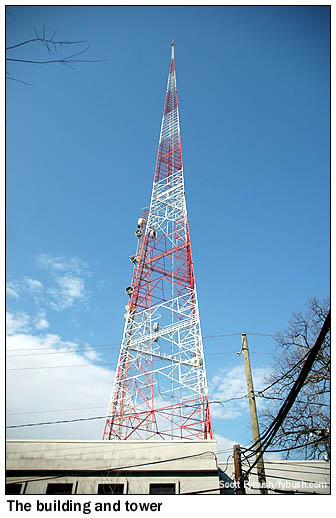 May 21, 2010
May 21, 2010
TBS, Atlanta, 2009
There are some cities where it's our habit to visit in a leisurely fashion; later this summer, for instance, we'll be spending the better part of a week in Boston, mixing radio fun with some of our other hobby interests. Then there are cities that, for whatever reason, seem to prompt a rush of activity. Later this year here on Site of the Week, you'll see the results of a whirlwind two-day train trip from Rochester to Chicago last June to see that market's analog TV just days before it went away.
Another market that always seems to get jam-packed with activity for us is Atlanta. Maybe it has something to do with the often dirt-cheap plane tickets that make it easy for a quick getaway, or maybe it's something about the friendly radio folks who go out of their way to show off the market - but in any event, our February 2009 trip to Atlanta was another nonstop whirl of studios and transmitter sites, much like our last two-day visit back in 2004 (chronicled here and in three previous 2005 installments.)
But amidst that whirl, there was one particularly historic site that was the highlight of our time in Atlanta, a site we'd seen plenty of times from the outside, but never from within.
Welcome to 1018 West Peachtree Street, just north of downtown Atlanta, an address that first entered the annals of Atlanta broadcasting in 1949, when Storer Broadcasting put WAGA-TV (Channel 5) on the air here from a state-of-the-art studio building and a short tower out back.
As we explained in our last installment, WAGA's tenure at this location was relatively short - in 1955, it built a much taller tower at 1551 Briarcliff Road, on what were then the outskirts of town to the northwest, and in 1965, Storer left the studios at 1018 West Peachtree behind as well, moving to the new (but classically Storer Colonial-style) studio building at the Briarcliff site that we featured last week.
The studios didn't stay vacant for long, though: in 1967, Jack Rice, Jr. took over the building to house his new UHF independent station. The signal on channel 17 bore Rice's initials - WJRJ - but instead of the old WAGA tower, Rice built a massive new self-supporting tower, just over a thousand feet in height, to give Channel 17 as much signal punch as a UHF station could enjoy back in that era of low-sensitivity tuners and lousy antennas. (I'm told the big self-supporter was financed by GE, which also provided the original channel 17 transmitter here.)
That tall tower was about the only thing WJRJ had going for it in those early years, which might explain why Rice was quick to sell Channel 17 in 1970, when the entrepreneurial son of a Georgia billboard owner came calling with the idea that it might be fun to own a television station.
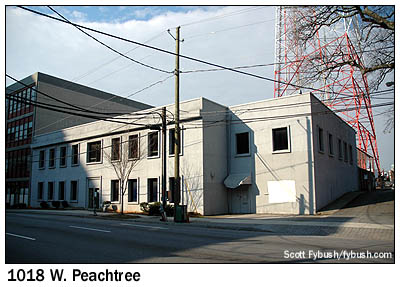
|
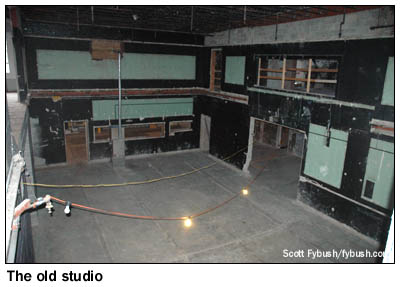
|
The rest of the story, of course, is the stuff of legend: that billboard owner's son was one Robert E. Turner, better known as "Ted," and when he took over channel 17, changing the calls to WTCG ("Turner Communications Group"), he gave birth to the nation's first "Superstation", all emanating from that old WAGA building in front of the tall tower on West Peachtree.
In its early years, WTCG ran on a shoestring, at one point holding an on-air telethon just to raise enough money to keep the station on the air for a few more weeks. There were lots of old movies, a slapstick late-night newscast anchored by Bill Tush, Atlanta Braves games and a growing network of microwave relays carrying the signal all over the South. In 1976, WTCG's signal went up on the Satcom I satellite, becoming the first national superstation and sparking a rapid flurry of growth that included Turner's purchase of the Braves (to ensure a ready supply of programming), the addition of a UHF station in Charlotte, N.C. to the Turner empire, a call change in 1979 to WTBS ("Turner Broadcasting System"), calls obtained from the MIT radio station up in Cambridge, Massachusetts - and then, in 1980, the sale of the Charlotte station to fund the wild gamble on an all-news cable channel.
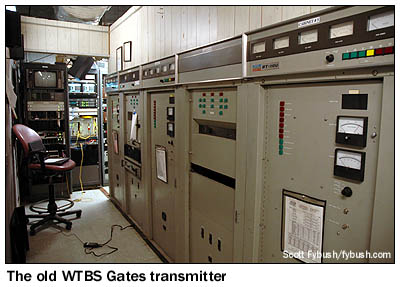
|
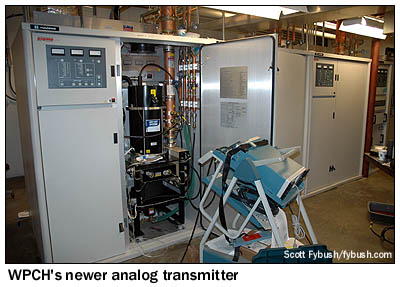 |
The launch of CNN led, slowly, to the demise of 1018 West Peachtree: with no room to build a new cable channel in the cramped quarters on Peachtree, Turner bought a failed country club just to the west, across I-75/85, turning its clubhouse into the new CNN/WTBS headquarters.
In the years that followed, the front of the 1018 building was occupied by Comcast, which used it for offices and for storage, but by the time we visited in February 2009, in the waning days of analog television, Comcast had moved out, leaving behind only a series of gutted spaces full of dust and ghosts. (If the walls of that big empty studio at the middle of the building could talk...)
When we finally made it to 1018 West Peachtree for a tour, the only room still active in the building was the Channel 17 transmitter area, occupying a small space at the rear of the building behind what had been the WTBS control room and studio. The old WTBS Gates BT-110U transmitter, dating back to the 1970s, remained in place as a backup, supplanted in 1999 by a newer Harris Sigma (seen above in the midst of a tube replacement.)
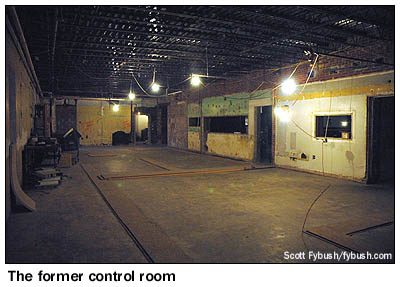 |
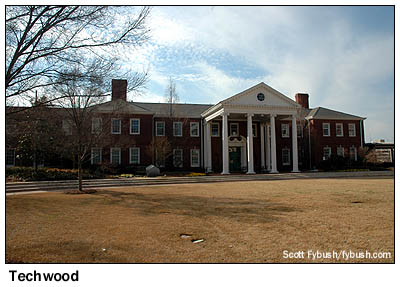
|
But by then, WTBS itself had become a relatively small cog in the Turner empire, especially after Time Warner swallowed Turner in 1996. Instead of being a local Atlanta station fed to the nation (indeed, at one time, FCC rules mandated that the satellite feed had to shut down if the broadcast transmitter went off the air, leading Turner to install a low-power auxiliary channel 17 transmitter at Techwood just in case), "TBS" eventually became a national cable network that happened to be broadcast locally in Atlanta on a UHF signal. By the early years of the 21st century the only difference between the national TBS feed and the local Atlanta WTBS feed was a legal ID at the top of the hour, a Saturday-morning public affairs show, and some separate advertising content.
On October 1, 2007, channel 17 finally split from its TBS heritage completely, becoming a local independent station known as "Peachtree TV," with new calls WPCH-TV. By then, 1018 West Peachtree's days were seriously numbered, since WTBS-DT/WPCH-DT (on RF channel 20) was constructed at a different site, a Richland-owned tower located, ironically enough, right across Briarcliff Road from WAGA. When channel 17's analog signal went dark for good on June 12, 2009, this tower went dark as well, apparently slated for eventual dismantling.
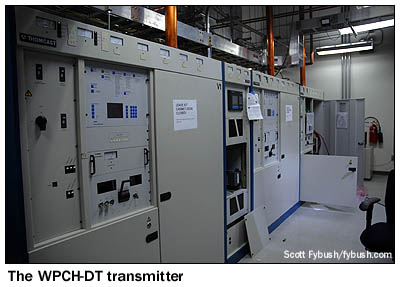
|
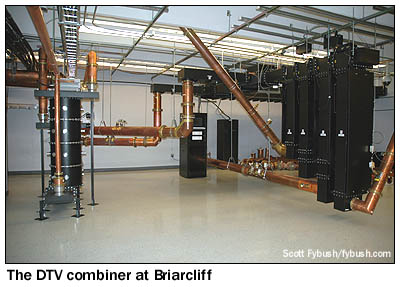
|
In a previous installment, we showed you some of the FM stations that call the Richland tower at Briarcliff home - but that site is also home to four TV stations, including WPCH-DT (Channel 20), which uses that Comark transmitter shown above.
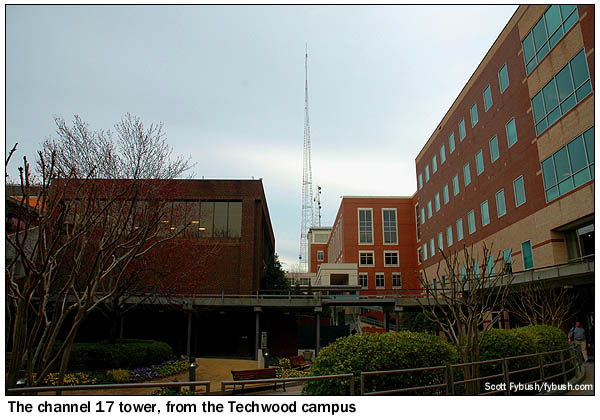 When
we visited in early 2009, WPCH-DT fed its signal upstairs into
the four-station combiner shown above at right. In addition to
channel 20, the combiner also had ports for WATL's channel 36
analog signal, WUVG-DT (channel 48) and an empty channel 41 port
that was apparently intended at one time for religious station
WATC, whose digital signal instead comes from a different site.
When
we visited in early 2009, WPCH-DT fed its signal upstairs into
the four-station combiner shown above at right. In addition to
channel 20, the combiner also had ports for WATL's channel 36
analog signal, WUVG-DT (channel 48) and an empty channel 41 port
that was apparently intended at one time for religious station
WATC, whose digital signal instead comes from a different site.
From the transmitter sites, we turn our attention back to the Techwood campus, where the old country club "mansion" from 1981 has spawned a huge complex of buildings. The mansion still sits at the center of the property, augmented by several additions that were tacked on to the back to provide additional space for CNN, Headline News, TNT and Turner's other early networks. (Another building directly across I-75/85 also provided early growth room for the Turner networks.)
In more recent years, the campus has grown dramatically: flanking the mansion on the Techwood Drive side of the property are two large office buildings, one housing administrative offices, the other home to a sophisticated master control and technical operations center for all of Turner's cable networks. Spreading out on the Tenth Street side are more new buildings providing space for many of Turner's back-end operations, including marketing and promotion and a large studio facility where everything from NBA pre-game shows to Turner Classic Movie intros are produced.
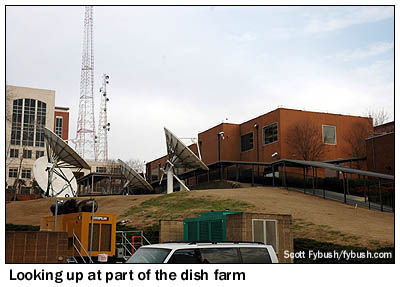
|
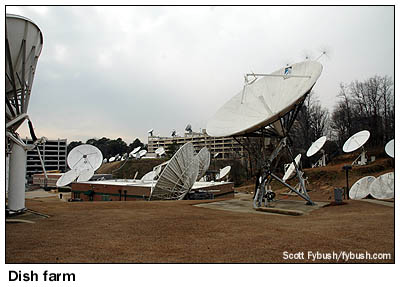
|
The north side of the campus is home to Turner's satellite facility, with dozens of dishes dotting the hillside below the mansion. There are two buildings here filled with rows of satellite uplink transmitters and receivers, pulling down incoming feeds and sending the Turner cable networks up into space.
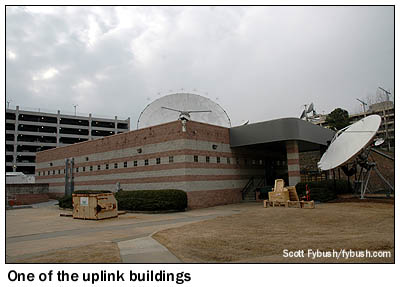
|
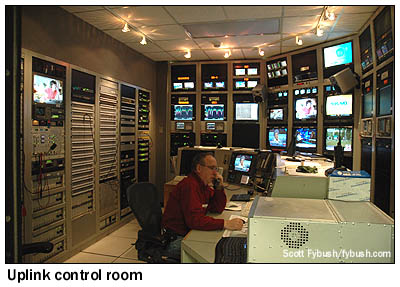
|
(Turner deserves a tremendous amount of credit for pioneering satellite delivery of cable programming: it was Ted Turner's prescient notion of putting the WTCG signal up on the satellite in 1976 that not only saved his struggling TV station but paved the way for national satellite distribution of hundreds of cable channels. Until WTCG went up on the satellite, the handful of cable networks that then existed were regional affairs like the early HBO, distributed only in select areas via microwave or private coax systems. Once cable systems installed dishes to receive WTCG, that all changed very quickly, and it all started here in Atlanta.)
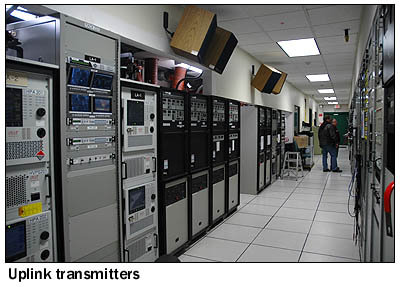
|
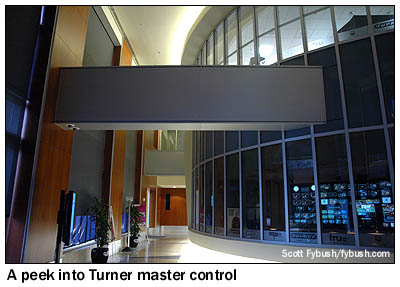
|
Today, there are literally dozens of networks coming from this facility: TBS, TNT, Cartoon Network, Boomerang, Turner Classic Movies, TruTV, plus international versions of those channels - and that's not even counting CNN, HLN and their sister networks, which moved out of Techwood in 1987 to the new CNN Center in downtown Atlanta.
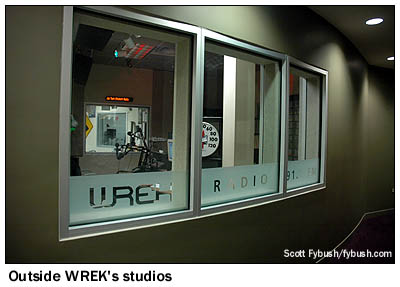 |
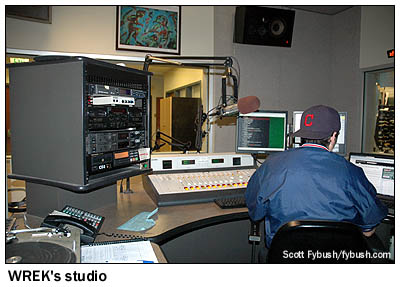 |
There's still one last stop on our Atlanta itinerary before heading to the airport for our flight home. "Techwood" draws its name from the nearby Georgia Tech campus, which sprawls just south of the Turner campus. Tech has a very long history of broadcasting, dating back to the early 1920s and one of Georgia's first radio stations, WGST. While that station eventually became a commercial outlet with no student involvement (and was finally sold to a commercial operator in 1973), a new student station, 10-watt WREK (91.1), made its debut from the Tech campus in 1968, using a homebrew transmitter built by student Geoff Mendenhall, who later went on to BE (where he designed the BE FM-10A transmitter that WREK would later use) and eventually to Harris.
 |
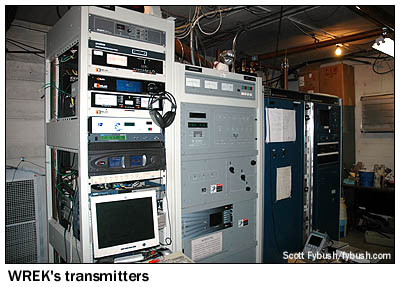 |
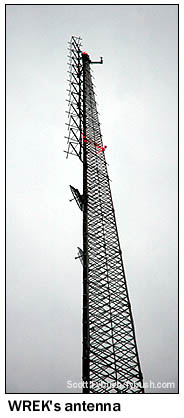 Today,
WREK is a 40,000-watt signal with modern studios in the student
center (replacing the old studios in the Alexander Memorial Coliseum,
where WGST had operated from 1956 until 1975) and a transmitter
site on the western edge of the campus.
Today,
WREK is a 40,000-watt signal with modern studios in the student
center (replacing the old studios in the Alexander Memorial Coliseum,
where WGST had operated from 1956 until 1975) and a transmitter
site on the western edge of the campus.
When we stopped by in early 2009, WREK had recently inaugurated HD Radio operation, with a new Harris HD/HT+ transmitter and a new HD2 channel carrying a mix of WREK's music formats and providing a home for shows preempted by Georgia Tech sports coverage.
Outside the transmitter building, in the last gasp of daylight, we catch a glimpse of the 10-bay Jampro antenna on the self-supporting tower - and then it's off to the nearby Varsity restaurant for a quick bite to eat before the end of another very satisfying visit to Atlanta.
This Tower Site of the Week installment comes with audio over at TopHour.com, where you can hear a whole bunch of 2009 IDs from Atlanta - and in the meantime, we urge you not to miss your chance to grab one of the dwindling remaining stash of the all-new Tower Site Calendar 2010, just in time to fill that space on the wall where your 2009 edition once hung.
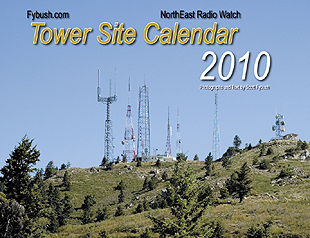 (It's
more than just pretty pictures and dates - the modest sum we
raise from each year's calendar helps make possible the travel
needed to make this feature happen every week on the website...and
we're grateful for all your support!)
(It's
more than just pretty pictures and dates - the modest sum we
raise from each year's calendar helps make possible the travel
needed to make this feature happen every week on the website...and
we're grateful for all your support!)
- Previous Site of the Week: Atlanta, 2009, part II
- Next Week: TBA
- Site of the Week INDEX!
- How can you help support Site of the Week? Click here!
- Submit your suggestions for a future Site of the Week!
